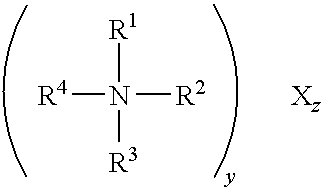Hydrocarbon compositions
- Summary
- Abstract
- Description
- Claims
- Application Information
AI Technical Summary
Benefits of technology
Problems solved by technology
Method used
Image
Examples
examples
[0242]The stability reserve of a hydrocarbon as well as the enhancement of hydrocarbon stability reserve by utilization of conductivity additives described in the invention were evaluated by measuring the hydrocarbon separability number.
Separability Number Test Method:
[0243]The Separability Number of the hydrocarbon is measured by using procedures described in ASTM D-7061-04 Standard Test Method for Measuring n-Heptane Induced Phase Separation of Asphaltene-Containing Heavy Fuel Oils as Separability Number by an Optical Scanning Device, the entire teaching of which is incorporated herein by reference
[0244]In D-7061-04, the fuel under test is diluted with toluene and the oil / toluene mixture is added to heptane in a tube. The tube is shaken and put in a vertical orientation into a Turbiscan optical scanning device, available from Formulaction of Toulouse, France. The Turbiscan device has a vertically moveable light source and detector, and constantly scans the tube vertically, complet...
PUM
 Login to View More
Login to View More Abstract
Description
Claims
Application Information
 Login to View More
Login to View More - R&D
- Intellectual Property
- Life Sciences
- Materials
- Tech Scout
- Unparalleled Data Quality
- Higher Quality Content
- 60% Fewer Hallucinations
Browse by: Latest US Patents, China's latest patents, Technical Efficacy Thesaurus, Application Domain, Technology Topic, Popular Technical Reports.
© 2025 PatSnap. All rights reserved.Legal|Privacy policy|Modern Slavery Act Transparency Statement|Sitemap|About US| Contact US: help@patsnap.com



